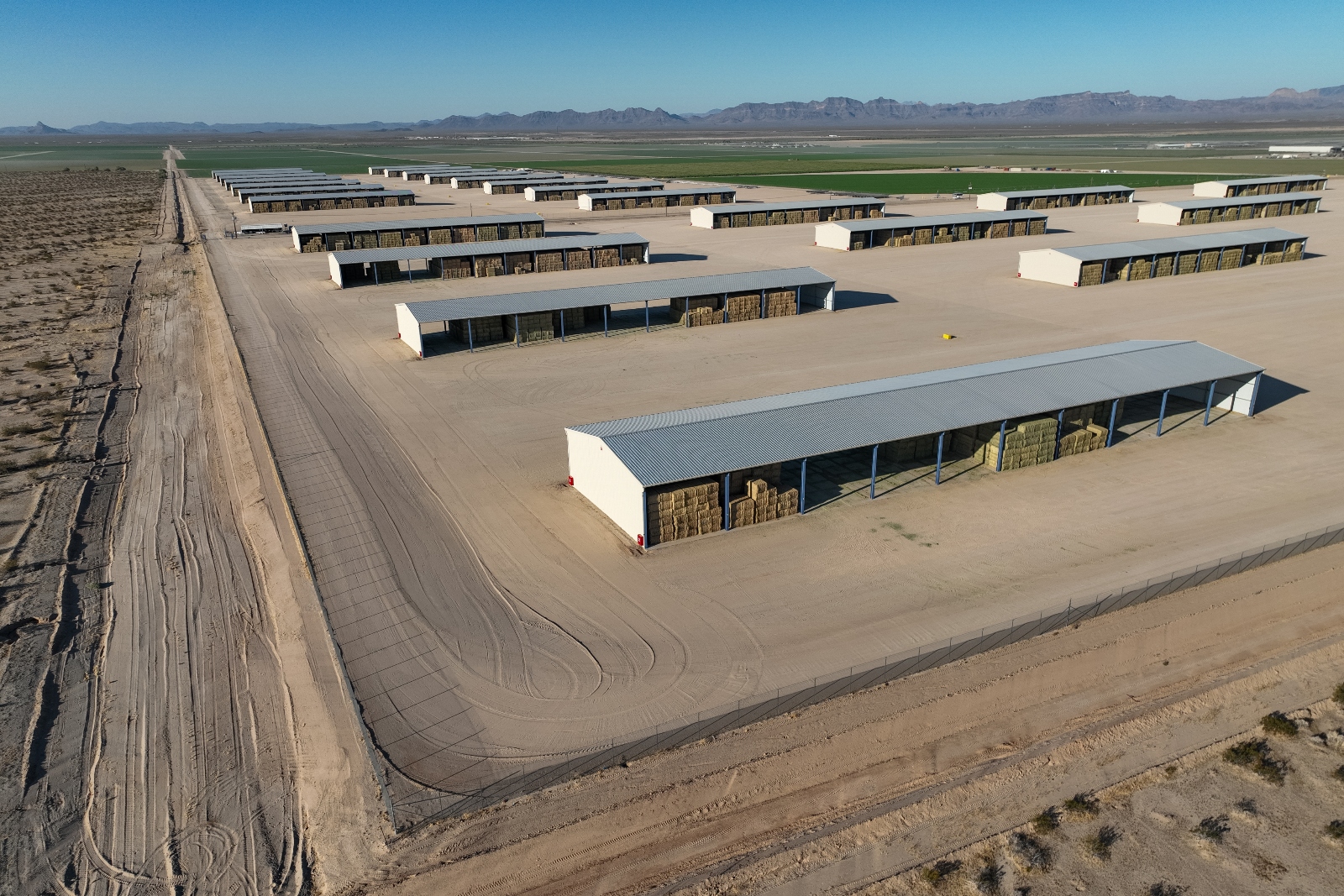
As Arizona struggles to adapt to a water shortage that has dried out farms and scuttled development plans, one company has emerged as a central villain. The agricultural company Fondomonte, which is owned by a Saudi Arabian conglomerate, has attracted tremendous criticism over the past several years for sucking up the state’s groundwater to grow alfalfa and then exporting that alfalfa to feed cows overseas.
Governor Katie Hobbs responded to those calls for action on Monday when she canceled one of Fondomonte’s four leases in the state’s rural Butler Valley and pledged not to renew the other leases when they expire next year. Hobbs, a Democrat who took office earlier this year, said in a statement about the decision that the company “was operating in clear default” of its lease and had violated state laws around hazardous waste. She also pledged to “hold defaulting, high-volume water users accountable” and “protect Arizona’s water so we can sustainably grow for generations to come.”
That will require Hobbs to tackle a problem that is larger than just one company. Agriculture accounts for around three-quarters of Arizona’s water use, and alfalfa is one of the most water-intensive crops in the West. The state may have managed to fend off one egregious company, but fixing the region’s overall water deficit will involve much harder political and economic choices.
“I think the governor was looking for a reason to cancel these leases,” said Kathleen Ferris, a senior research fellow at Arizona State University’s Kyl Center for Water Policy and an architect of the state’s landmark 1980 groundwater law. “But the bigger problem is unregulated use of groundwater in rural areas of the state. That’s the big elephant in the room — we are just not addressing this use of groundwater, and it’s finite.”
Fondomonte’s aggressive water use in Butler Valley has drawn attention to Arizona’s lax groundwater regulations and the high water demand of crops like alfalfa. The state has set limits on groundwater pumping around population centers like Phoenix and Tucson, but companies in rural areas can still pump as much as they want with no restrictions, even if that means sucking water away from neighboring homes and businesses.
To make matters worse, the Saudi-owned company operates on a section of state-owned land in a valley northwest of Phoenix, and it pays just $76,000 per year to lease that land from the state. In most parts of Arizona, it’s illegal to move water from one basin to another, but state lawmakers had marked the Butler Valley in the 1980s as one of two places that might someday send water to thirsty Phoenix. (Saudi Arabia outlawed the production of alfalfa and other crops in 2018 amid a severe water shortage in the country.)
Fondomonte has said it will appeal Hobbs’ decision, but even if Arizona succeeds in forcing out the company, the state will still have a big alfalfa problem. The hay plant is one of the most water-intensive crops in the United States, requiring about five acre-feet of water per acre each year. An acre-foot of water is equivalent to 326,000 gallons, or enough water to supply two average homes for about a year. Fondomonte told the state government in a letter in February that it grows about 7,000 acres of alfalfa in Arizona.
Producing the crop was a big business in Arizona before the Saudis arrived around a decade ago, in large part because the state’s warm climate allows farmers to achieve much bigger yields than they do in other parts of the country. The state produced more than 2 million tons of alfalfa in 2021, or about 8.2 tons for every acre planted. That’s much more than the national average of 3.2 tons per acre. Fondomonte’s production accounted for a small part of that: In its February letter, a company official said the firm produced only 70,000 tons of the crop every year, or 2.5 percent of the state’s overall output.
Tackling the larger water footprint will be far more difficult. Fondomonte was operating on state land that it had acquired at cut-rate prices, but most of the state’s alfalfa production takes place on private land. That’s the case in Cochise County, on the state’s southeast edge, where rural residents have lost out on well water since corporate giant Riverview Dairy started growing alfalfa in the area. Other foreign nations have also gotten in on the business: A United Arab Emirates-based company called Al Dahra grows and exports alfalfa in La Paz County, with support from the state’s own pension fund. Fondomonte itself has other operations on private land in Vicksburg, near Butler Valley.

“We have a church that’s just up the road from them in Vicksburg, and they haven’t had water for three years,” said Holly Irwin, a member of the La Paz County Board of Supervisors who has fought Fondomonte. She praised Hobbs for canceling the lease, but worried that the state could lease the same acreage to another company that might take over the farm.
“Moving forwards, they’re going to have to evaluate how things are done, and maybe restrict the amount of water that comes out of each well,” she said.
Foreign corporations aren’t the only ones responsible for Arizona’s groundwater shortage, though. The state exported around 22 percent of its alfalfa crop last year, up from almost none in 2011, but the vast majority of its crop still goes to feed dairy cows within the state or in other parts of the West. Moreover, most of the state’s largest groundwater pumpers, such as Riverview and Peacock Nuts, a massive nut farm operation in the western part of the state, are owned and based in the U.S. Without action from lawmakers, Hobbs can’t do anything about this overdraft on private land, even though these companies may be taking just as much water as Fondomonte.
“Our concern is that one of the things that the governor mentioned in her press release was the idea that the water use was one of the determining factors in canceling those leases,” said Philip Bashaw, the CEO of the Arizona Farm Bureau, which advocates for the state’s farmers. “We are concerned about the precedent this might set for other agricultural leases on state land.” The state leases about 150,000 acres of its trust lands for agriculture, or 1.6 percent of its total acreage.
In a statement to Grist, Fondomonte said the company hadn’t broken the terms of its state lease and vowed to appeal Hobbs’s decision. A spokesperson said the company “remains committed to progressive, efficient agricultural practices on all operations.”
In some cases, locals have fought back against thirsty corporations, but progress has been difficult. Residents of Cochise County voted last year to impose new water restrictions in one overtapped groundwater basin, but the basin’s largest dairy and nut farms would be grandfathered in under the new rules, and they won’t have to slow down their pumping. Another referendum in a nearby basin failed after organizations backed by Riverview mounted a lobbying campaign to oppose it.
There aren’t any other takers right now for the water in Butler Valley, but alfalfa’s water demand presents an acute problem in the state’s population center of Maricopa County, which in 2017 produced around 30 percent more alfalfa than La Paz County, where Fondomonte operates, according to USDA statistics. Farms in the Phoenix area have been draining groundwater for decades to grow alfalfa and other crops, and until the turn of the 21st century they used more water than the county’s 4 million residents did. That’s despite the fact that Phoenix has far stricter groundwater regulations than rural areas like Butler Valley.
It’s not only Arizona that has embraced the crop. California, Oregon, Idaho, Colorado, and Utah all boast alfalfa farms that stretch across thousands of acres, and the crop has guzzled up plenty of water in these states, too. According to one estimate, alfalfa and other silage crops account for as much as 55 percent of water usage in the Colorado River basin, and more than half the water usage in Utah, the nation’s second-driest state.
The reason for this is simple: Alfalfa is a lucrative business. The hay product fetched about $320 per ton in 2022, up from $210 the year before, making it more lucrative than other large-scale crops like wheat. It provides nutritious and healthy feed for cattle and dairy cows, which means there’s significant demand for it both in the United States and overseas in places like Saudi Arabia.
“The vast majority of the alfalfa that’s grown in Arizona is grown to support our local agriculture industry, which is there to support the urban areas,” said Bashaw, adding that the hay feeds cows that produce goods like milk, cheese, and beef, and that more than 70 percent of those goods are sold within the state. “Alfalfa is a really critical part of being able to source dairy products locally for a large metropolitan area.”
For as long as companies can harvest ample water from underground aquifers, or from the Colorado River, they’re likely to keep growing it wherever they can, and water sources across the region will keep dwindling.
“The longer this goes on, the bigger the problem,” Ferris told Grist, “because the more land that gets put into cultivation, the harder it is to do anything to control the depletion. As long as farmers have the ability to pump water, they grow what they think is the most valuable crop.”
This story was originally published by Grist with the headline Arizona is evicting a Saudi alfalfa farm, but the thirsty crop isn’t going anywhere on Oct 6, 2023.

